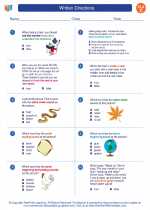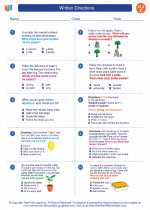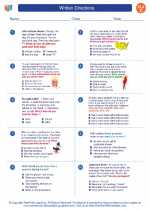Written Directions
Definition: Written directions are a set of instructions or guidance provided in text form to help individuals understand how to perform a specific task or reach a particular destination.
Types of Written Directions
There are different types of written directions, including:
- Procedural Directions: These provide step-by-step instructions on how to complete a task or activity.
- Navigational Directions: These guide individuals on how to reach a specific location or destination.
- Instructional Directions: These offer guidance on how to use a particular tool, device, or product.
Key Elements of Written Directions
Effective written directions typically include the following elements:
- Clear Language: Instructions should be written in a clear and understandable language, avoiding jargon or complex terminology.
- Sequential Order: Steps should be presented in a logical and sequential order to ensure clarity and ease of understanding.
- Visual Aids: Incorporating visual aids such as diagrams, maps, or pictures can enhance comprehension and assist visual learners.
- Warnings or Precautions: When necessary, directions should include warnings or precautions to ensure safety and prevent errors.
Study Guide for Written Directions
Here are some tips for effectively understanding and following written directions:
- Read Carefully: Take your time to read through the directions thoroughly, ensuring that you understand each step before proceeding.
- Highlight Key Information: Use a highlighter or underline important details and key steps to make them stand out for easy reference.
- Ask for Clarification: If you encounter any ambiguity or confusion, don't hesitate to seek clarification from a teacher, parent, or supervisor.
- Practice: Practice following written directions by engaging in activities that require adherence to instructions, such as following a recipe or assembling a model kit.
- Seek Feedback: After following written directions, seek feedback from others to evaluate your understanding and performance.
By understanding the types and key elements of written directions, as well as following the study guide tips, individuals can enhance their ability to comprehend and execute written instructions effectively.
[Written Directions] Related Worksheets and Study Guides:
.◂English Language Arts Worksheets and Study Guides Third Grade. Written Directions
Worksheet/Answer key Written Directions
Written Directions  Worksheet/Answer key
Worksheet/Answer key Written Directions
Written Directions  Worksheet/Answer key
Worksheet/Answer key Written Directions
Written Directions 

 Worksheet/Answer key
Worksheet/Answer key
 Worksheet/Answer key
Worksheet/Answer key

The resources above cover the following skills:
Comprehension of Informational Text
Develop comprehension skills by reading a variety of self-selected and assigned print and non-print informational texts, including electronic media
Read, use, and identify the characteristics of functional documents such as sets of directions, science investigations, atlases, posters, flyers, forms, instructional manuals, menus, pamphlets, rules, invitations, recipes, advertisements, other functional documents
Identify and use text features to facilitate understanding of informational texts
Use informational aids such as introductions and overviews, materials lists, timelines, captions, glossed words, labels, numbered steps, pronunciation key, transition words, boxed text
Use organizational aids such as titles, chapter titles, headings, subheadings, tables of contents, numbered steps, glossaries, indices, transition words
Comprehension of Literary Text
Use text features to facilitate understanding of literary texts
Identify and explain how informational aids such as introductions and overviews, materials lists, timelines, captions, glossed words, labels, numbered steps, bulleted lists, footnoted words, pronunciation keys, transition words, end notes, works cited, other information aids encountered in informational texts contribute to meaning